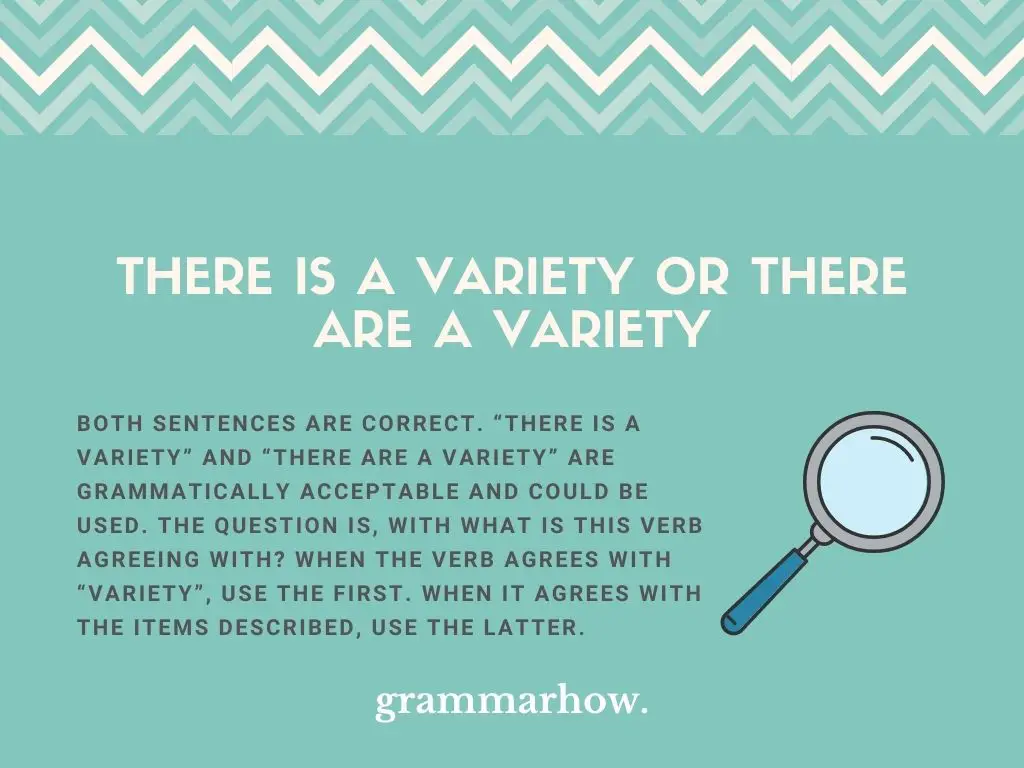Should we say “There Is a Variety” or “There Are a Variety”? What is the correct verb in those sentences, “Is” or “Are”?
Let’s try to find out which is the correct version of that sentence, and how to use it.
There Is a Variety or There Are a Variety
Both sentences are correct. “There Is a Variety” and “There Are a Variety” are grammatically acceptable and could be used. The question is, with what is this verb agreeing with? When the verb agrees with “variety”, use the first. When it agrees with the items described, use the latter.

This might sound complicated at first, but let’s take a look at the examples:
- There is a variety of cars to choose from.
- There are a variety of cars to choose from.
Both sentences may seem the same at first. But let’s look closely, and discover what the verb is agreeing with.
In the first sentence, we say “There Is a Variety”, placing the focus of the sentence on the concept of variety. The verb in this sentence agrees with “a variety”, not with cars.
In the second sentence, we use “There Are a Variety”, changing the focus to the cars themselves. In this sentence, “are” is agreeing with “cars”, and not with “variety”.
Still feeling confused? Let’s look at each form separately.
There Is a Variety
“There Is a Variety” is the correct form to use in two instances: when you want your verb to agree with the concept of “Variety” or when the category presented in your sentence is in the singular form.
Take a look at some examples below:
- When it comes to activities to do around town, there is a variety to choose from.
- There is a variety of food available at the party.
- If different clothing styles are what’s on your mind, you’ll find a variety at the store.
- There is a large variety of furniture at that shop.
- Shelters go about caring for pets in a variety of ways.
In all of those sentences, if you pay close attention, the emphasis is placed either on the concept of variety, or in a category presented in the singular form.
In sentences 1 and 3, the focus is on the variety, the idea that there’s plenty and the items are all part of the same group.
In sentences 2 and 4, the category is presented in the singular form: we discuss the “variety of food” and the “variety of furniture”. In those cases, “There Is a Variety” is grammatically correct to appear.
There Are a Variety
“There Are a Variety” should be used when the focus of the sentence is the group of things presented as a variety (and not the concept of variety itself). Also, that group or category should be presented in the plural form.
Take a look at the examples we put below:
- There are a variety of ways to go about this.
- There are a variety of answers that Sarah could use to respond.
- There are a variety of snacks in the pantry.
- There are a variety of books in the library.
- There are a variety of pastries available in the bakery.
In those sentences, the focus is always on the items for which there’s a variety available. Those items could be literal or figurative, and it’d still work just the same.
Which Is Used the Most?
Do we say “There Is a Variety” or “There Are a Variety” with more frequency? Let’s take a quick look at the graph from Google Ngram Viewer that has the answer for us.

“There Are a Variety” appears much more frequently than “There Is a Variety”. Although we cannot be sure of the reason why this is the case, we can make some assumptions.
First, it could be that “There Are a Variety” is correct more often than “There Is a Variety”, and consequently appear more often.
But it could simply be that people feel more comfortable using “There Are a Variety”, and that it has nothing to do with what would be the most correct form at all
Final Thoughts
Remember that “There Is a Variety” and “There Are a Variety” are correct and can be used. Use the first whenever your focus is the variety itself, or when the category is presented as singular. Use the latter when the focus is the category, presented in the plural form.

Martin holds a Master’s degree in Finance and International Business. He has six years of experience in professional communication with clients, executives, and colleagues. Furthermore, he has teaching experience from Aarhus University. Martin has been featured as an expert in communication and teaching on Forbes and Shopify. Read more about Martin here.
